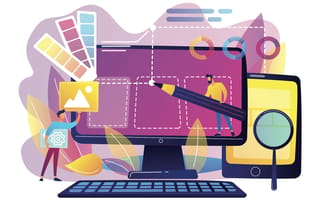For project44 Director of Design Systems Erin Mahoney, there’s a simple reason to turn to DesignOps.
“As we continue to hire and scale, it’s critical that we are set up for success in a sustainable way,” said Mahoney. “It made sense to establish DesignOps to allow our designers to focus on what they do best: design.”
It sounds easy — just let the company’s designers do what they were hired to do. However, that philosophy is often not present in an employee’s lived experience. Workfront’s 2020 “State of Work” report revealed that employees spend only 43 percent of their time performing their primary job duties. A sizable chunk of that other time is wasted due to inefficient productivity systems, miscommunication and ineffective strategic alignment.
Design is a creative and innovative field, and designers especially benefit from the time and space to do their work — which can only be granted if design operations are well in hand. Mahoney’s design team uses DesignOps principles to make sure that happens.
“DesignOps leads and advocates for all workflows and processes that designers comply with,” she said. “We are able to build more resilient workflows across all of design while also activating collaboration across a scaling design team.”
Implementing DesignOps is not a simple fix — a company needs to keep it in mind for team structure, onboarding and day-to-day functionality. In a conversation with Built In Chicago, Mahoney shared how her company uses DesignOps every day to help their designers design without worry.
What first prompted your team to explore the concept of DesignOps?
Design is relatively new at project44. As we continue to hire and scale, it’s critical that we are set up for success in a sustainable way. Luckily, other functions like engineering and product have already held a strong operational presence at the company.
Speaking more personally, working in design systems has naturally allowed me to explore the operational space. At the heart of any good design system is functional enablement for each role. I’m thrilled to be able to support our designers through their processes, tools, onboarding and hiring.
What does DesignOps look like at your company? What were the key steps you took to develop and implement this DesignOps practice?
Currently, myself and other design leadership members help to establish a successful scaling design team through DesignOps.
This includes an in-depth, two-week onboarding experience at our Chicago headquarters. In this experience, we focus on establishing close team bonds — building connections over lunch, whiteboarding together and making time for team social events are key — while we cover the purpose of design and DesignOps at project44. Each new designer comes away with a consistent and shared understanding of their community, tools, resources and support.
We also want to ensure that every designer builds a connection to the business and industry, so we set up training sessions that cover different product areas. Our seasoned team members often give lunch-and-learns or learning presentations in their area of expertise, which are available via Zoom for those remote and recorded for posterity for others to watch later.
Outside of onboarding, we implement review and critique to help make more efficient design decisions together. Regardless of the product team that they’re embedded on, all designers come together to discuss their craft and help each other learn and grow through constructive feedback.
DesignOps prefers to support the tools that our designers choose and work with best.”
As your team scales, how are you continuing to leverage and evolve your DesignOps practice?
Our approach is two-fold: Listen to the team and aim for shared processes.
First, it’s important to always engage and listen to our designers to ensure that we provide the right information and tools necessary to help them do their job. We’ve already made some updated decisions around design tooling based on workflow feedback and desire to consolidate said tooling. Rather than being strongly opinionated, DesignOps prefers to support the tools that our designers choose and work with best.
Second, we care about aligning on shared processes. DesignOps leads and advocates for all workflows and processes that designers comply with. Regardless of the tool, we are committed to things like version control and non-destructive workflows; it’s essential for our designers to not only understand but to buy into the value of such a practice. By doing this, all designers can have confidence that others follow the same processes too. It removes ambiguity and redundancy across work. We are able to build more resilient workflows across all of design while also activating collaboration across a scaling design team.










.png)